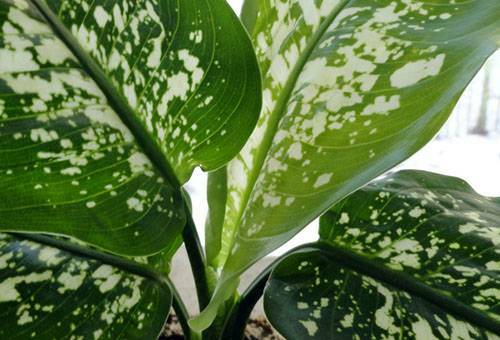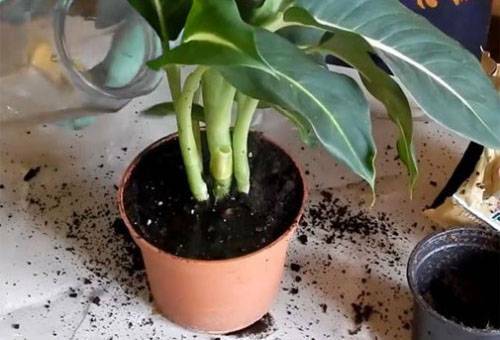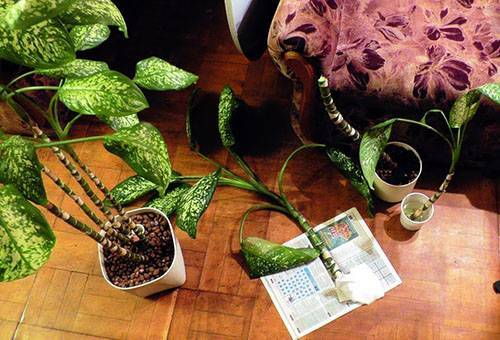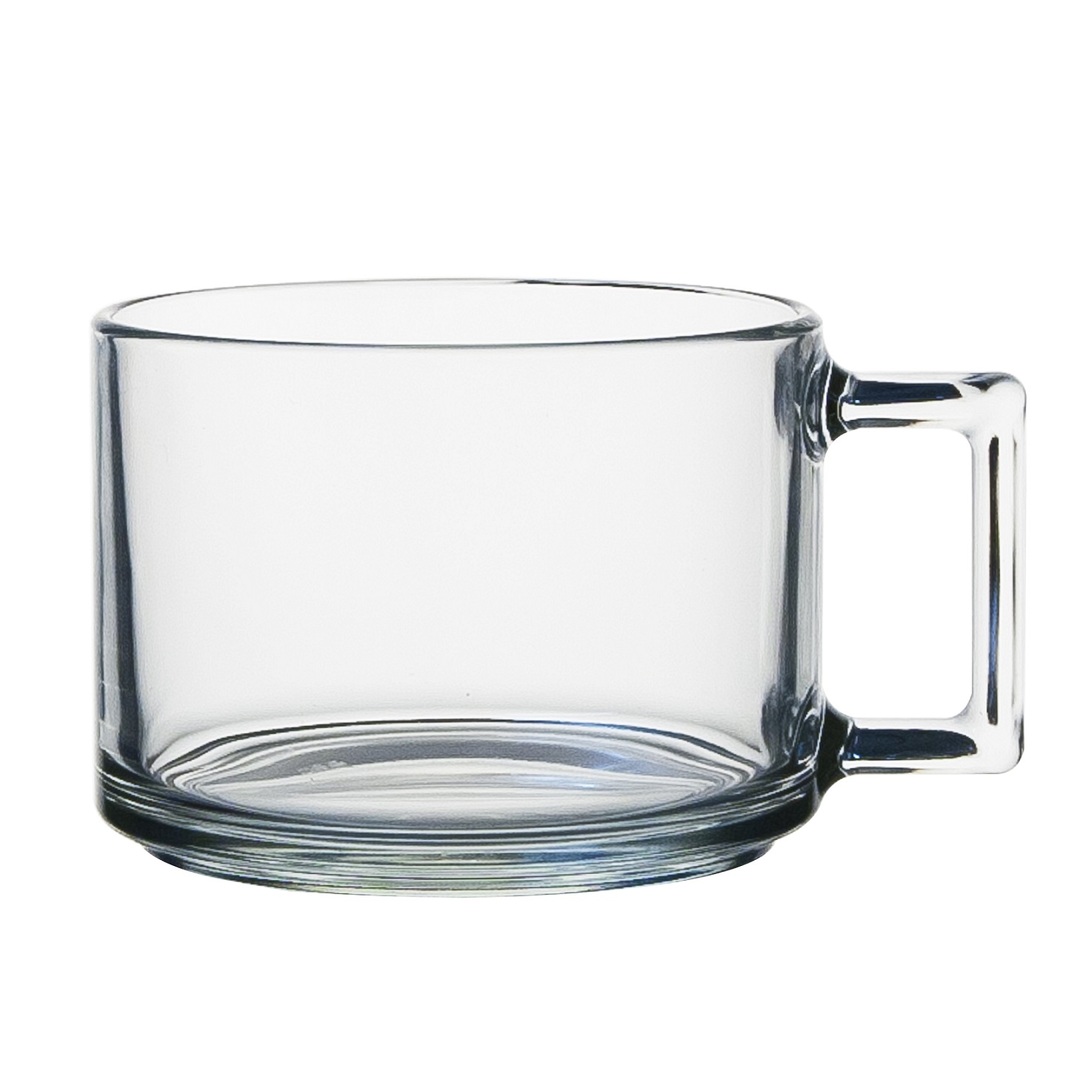Contents:
- Difficulties in growing dienenbachia
- Watering and top dressing
- Transplanting and pruning
- Reproduction by cuttings and layers
Many growers do not dare to grow dienenbachia, home care may seem rather complicated. But this plant of the family of aroids can give comfort to any room. Its value lies in large oval leaves. They are decorated with unusual patterns, depending on the variety: it can be "blots", stripes or stains on a dark green background.

Difficulties in the cultivation of the diffenbachia
Despite the beauty, due to certain properties of the diffenbachia, it is often feared to keep it in the house.
- These houseplants are poisonous, like most representatives of this family. Care must be taken when caring for them. In addition, it is important to ensure that children and animals do not have access to them.
- Dieffenbachia is characterized by rapid growth, new leaves appear every week. However, as a result of this process, she loses decorativeness and looks less elegant. Therefore, the plant is regularly cut with rooting.
- The plant does not tolerate the cold, drafts can also ruin it.
- Water for irrigation should be filtered through or filter-off, as lime can also damage the plant.
If these difficulties do not scare, then you can start growing a flower. It is necessary to comply with the temperature regime and other conditions for its successful growth. The preferred temperature is 20-25 degrees, in winter it can drop to 17. The choice of a place should also be taken responsibly. Dieffenbachia does not like direct sunlight, but in the shade it is also uncomfortable. It is best to place it at a distance of a meter from the window, so that the lighting is diffused. If you put further away from the window, then you can not do without artificial light sources.

Watering and feeding
Dieffenbachia does not like not only coolness, but also drafts. If you put it in an unsuccessful place, it will lose leaves, or even die. Also you need to monitor the humidity - the air should not be dry. It is desirable to sprinkle green leaves as often as possible from the spray gun and wipe with a wet cloth. Watering, especially if the room is hot, you need abundantly. But not excessively, the soil should not resemble dirt. Do not let the water stagnate in the pan. To damage the flower can both the drying of the earth, and excessive moisturizing.
Advice
If the plant is flooded, you should get the soil from the pot with the roots, wrapped in paper towels to draw out the moisture. Then put back.
Correct care for dienenbachia is impossible without top dressing. Every 10 days in spring and summer time it is necessary to feed the flower with organic or mineral fertilizers. They should not contain lime. This procedure promotes the growth of healthy leaves. If we are talking about a variety with light, white leaves, then organic does not fit. It contains nitrogen, because of which they are green.
In winter, plant care is slightly different. Reduce watering to prevent soil silt, but the moisture of indoor plants should receive enough. Particular attention should be paid to humidity, since in the cold season due to heating the air is usually dry. Diffenbachia may begin to dry the tips of the leaves. It must be regularly sprayed with water. You can use the old proven method - put next to the plant a small bowl filled with water. A very good effect gives the humidifier.

Transplanting and pruning
The transplanting and pruning of these plants is of great importance. They grow quickly, so you need to change pots a lot, or even two a year. The root system should be handled carefully so as not to damage it. The most suitable period is from February to May. The method of transshipment is used. In a new pot, whose diameter is a couple of centimeters larger than the previous one, a diffenbachia is transplanted along with a clod of earth. It must first be cleaned of the remnants of the old drainage. Soil fits neutral, it should not be excessively loose or heavy.
Not only transplantation is necessary at a rapid rate of growth of diffenbachia. It should be kept under control so that a small elegant bush does not turn into a two-meter tree. Therefore, it is necessary to conduct a pinch. If there are no leaves in the lower part of the trunk, it is better to make a deep pruning, leaving only a ten centimetric stump, so you can reproduce the flower. Also sometimes it is necessary to remove the damaged leaves.
To cut, use a sharp knife, pre-treated with a disinfectant. This tool gently cuts off part of the trunk or damaged sheet. Then the site with a cut must be soaked with a napkin so that the juice does not spill. Then pour pounded coal.
Important!
All work must be done with gloves, since diffenbachia is poisonous. Her juice, which gets on the skin, will cause itching, redness and other unpleasant sensations.

Propagation by cuttings and layers
Propagation of diffenbahia is carried out with the help of cuttings. This is the most convenient and reliable way. The easiest way to use it is when you need to update an old, barren age barrel. In this case, it is necessary to carefully cut off the upper part and blot the cut with a paper towel. Then, for rooting, the top is placed in water or wet sand. The stalk must be protected from direct sunlight, constantly sprayed so that it gets enough moisture. The temperature should be high enough.
It is also possible to propagate with stem stems. To do this, the bare stem in the pot must be divided into pieces with a knot in the middle. They should be left for a day, so they are dried. Then put on moistened peat mixed with sand, the kidneys should be directed upwards. After this, cover with a film and wait for rooting to be transplanted into the usual soil. Penie too, you can use: if it is properly watered, then it will shoot from the remaining nodes. When a pair of leaves grow on them, the shoots can be cut off and transplanted to effect rooting.
Reproduction can also be done by airlifting. This is a slightly more laborious process, but sometimes it is rational to use it. On the stem make a small incision, obkladyvayut moistened with moss and wrapped with a film. It is fixed with tape, thread or tape. After some time under it grow roots, then this section of the stem is cut. The film is carefully removed, and the mosses are planted in the soil.
Growing these houseplants is not easy. Care for dienenbachia includes regular transplantation, pruning and reproduction."Green friends" demand for themselves increased attention, compliance with the temperature regime and maintaining the right level of humidity. But they are excellent at cleaning air from a variety of harmful substances: formaldehyde, xylene, benzene and others. Most of all they will bring in the kitchen. It is there that there is a place for the flowerpot.
Read the article: storing grape cuttings in winter


